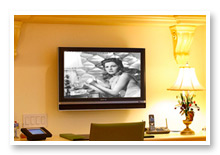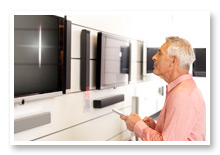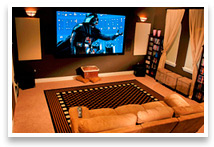Sound & Vision is dedicated to helping all our clients create an entertainment system that fits their needs and desires. If you have purchased a HDTV and would like to experience all that it has to offer, you have come to the right place.
HDTV Installation
 Installation of plasma and LCD televisions takes a level of skill that most of us do not have. The experts at Sound & Vision are here to help. We have been installing HDTVs for many years and have the expertise to handle any project.
Installation of plasma and LCD televisions takes a level of skill that most of us do not have. The experts at Sound & Vision are here to help. We have been installing HDTVs for many years and have the expertise to handle any project.
Let our team of experts help you with all your HDTV needs. Call us today for an estimate.
 For a long time, it was tough to call, but today's rapidly evolving technologies have made it easier to crown a winner in the display wars.
For a long time, it was tough to call, but today's rapidly evolving technologies have made it easier to crown a winner in the display wars.
When you're shopping for an HDTV, there are plenty of factors to consider. Chief among them is the type of display. While boxy, bulky CRTs are long dead and mammoth rear-projection HDTVs are all but extinct, the HDTV market currently offers three distinct choices in display technologies: plasma, traditional CCFL-backlit LCD, and LED-backlit LCD. For years, the question of which technology reigned supreme remained unanswered.
In the early days of HDTVs, plasma, with its inky blacks and top-notch picture quality, was the prevalent flat-panel technology, especially among videophiles. Gradually, thinner, more energy-efficient LCDs with CCFL backlighting became less expensive and more capable and started gaining ground. The difference between plasma and LCD wavered for some time, with each offering different economic and visual benefits depending on the model, price, and time in the life cycle of HDTVs. But in the past couple of years, with the advent of increasingly sophisticated LED backlighting, we finally have a true winner. With its unmatched energy efficiency, LED-based LCD is the best flat-panel HDTV technology. Unfortunately, it's also generally the most expensive. (Though LED HDTV prices have come down considerably over the past year, and continue to drop all the time.) If it's in your budget, the choice is clear: Pay the premium and get an LED-lit HDTV.
The Basics: What's the Difference Between LCD, LED, and Plasma?
The three technologies are vastly different, particularly how each screen is lit. In plasma HDTVs, the phosphors that create the image on the screen light up themselves, and don't need any backlighting. For LCD HDTVs, however, the liquid crystal screen does not illuminate, requiring a separate light source. That's where the difference between "regular" LCD screens (also known as CCFL-backlit LCD) and LED-backlit LCD screens (also known as LED-LCD, or just LED screens) come in. Traditional LCD HDTVs use cold cathode fluorescent lights (CCFLs) to illuminate the screen. CCFLs are similar to the fluorescent lights you might see in your lamps and overhead light fixtures. They use a charged gas to produce light. LED-LCD screens, like their name implies, use light emitting diodes (LEDs) to illuminate the display.
Several factors can be influenced by the type of HDTV display you choose. Among them, the most prominent are screen thickness, brightness, darkness, energy efficiency, and price. Ideally, you want an HDTV that's affordable, paper-thin, can get face-of-the-sun-bright and black-hole-dark, and consumes less than a watt. That's currently impossible, but LED-backlit LCD HDTVs can come closer than the other two technologies.
For this advantage, LED HDTVs command a premium; for all major HDTV manufacturers, LED-backlit HDTVs can cost a few hundred dollars more than CCFL-backlit HDTVs of the same size. Generally, plasma HDTVs tend to be the least expensive, priced at equal to or slightly less than CCFL-backlit HDTVs. However, that savings means the screen will be thicker and much more power-hungry, even if it does offer as good a picture as an LED-backlit HDTV. For example, Samsung's 46-inch CCFL-backlit LCD HDTVs begin at $799.99 (the 600 series), and can get as pricey as $1,699.99 (the 750 series). Samsung offers 50-inch 1080p plasma HDTVs (there are no 46-inch models currently available, and 52-inch CCFL-backlit LCDs start at $1,299.99 with the 530 series) for as little as $1,149.99 (the 540 series) and as much as $2,299.99 (the 8000 plasma series). For the extra size, that bump up in price is reasonable. Meanwhile, 46-inch Samsung LED HDTVs start at $1,199.99 (the 6050 LED series) and can become as expensive as $4,999.99 (the 9000 LED series). LED HDTVs don't have to be super-expensive, but they almost always cost more than their CCFL-backlit and plasma counterparts. Considering the excellent picture quality and significant benefits in screen thickness and power consumption, that extra amount on the price tag is well worth it.
 How good the picture looks, especially if you're a videophile or a cinema fanatic, is the most vital aspect of any HDTV. Specifically, peak white and black levels determine how detailed a picture can look on a screen. Poor white levels mean fine details can get washed out in bright scenes, while poor black levels mean shadows swallow up parts of the picture in dark scenes. A very wide gamut from dark to light lets the HDTV show the tiniest details, regardless of how bright or dark the movie gets. In our tests, we measure white and black levels by luminance using a chromameter. A mediocre HDTV might produce black levels of 0.05 to 0.07 cd/m2, while an excellent HDTV might offer levels of 0.01 to 0.03 cd/m2. Historically, plasma HDTVs have produced the best black levels, specifically the now-defunct Pioneer Kuro HDTV brand. The Kuro's screen got so satisfyingly dark that it remained a popular HDTV for enthusiasts long after Pioneer stopped making the sets. The domination of plasma in this field, however, is over. Our current Editors' Choice HDTV, the LED-based LG Infinia 47LW5600, puts out only 0.01 cd/m2, the best level we can measure. That any LED-backlit LCD can get that dark shows how far the technology has come.
How good the picture looks, especially if you're a videophile or a cinema fanatic, is the most vital aspect of any HDTV. Specifically, peak white and black levels determine how detailed a picture can look on a screen. Poor white levels mean fine details can get washed out in bright scenes, while poor black levels mean shadows swallow up parts of the picture in dark scenes. A very wide gamut from dark to light lets the HDTV show the tiniest details, regardless of how bright or dark the movie gets. In our tests, we measure white and black levels by luminance using a chromameter. A mediocre HDTV might produce black levels of 0.05 to 0.07 cd/m2, while an excellent HDTV might offer levels of 0.01 to 0.03 cd/m2. Historically, plasma HDTVs have produced the best black levels, specifically the now-defunct Pioneer Kuro HDTV brand. The Kuro's screen got so satisfyingly dark that it remained a popular HDTV for enthusiasts long after Pioneer stopped making the sets. The domination of plasma in this field, however, is over. Our current Editors' Choice HDTV, the LED-based LG Infinia 47LW5600, puts out only 0.01 cd/m2, the best level we can measure. That any LED-backlit LCD can get that dark shows how far the technology has come.
White levels don't matter quite as much as black levels, because it's more difficult for screens to show fine details in shadows and easier to crank out very bright whites with backlighting, but they can still matter. At this, LED backlighting again triumphs. The Panasonic TC-L42E30 reaches a staggering 473.50 cd/m2 white levels with modest 0.04 cd/m2 black levels. It completely (and literally) outshines the Panasonic TC-P50ST30, its plasma HDTV cousin that puts out only 107 cd/m2 peak white while offering a slightly better 0.03 cd/m2 black level.
Size and Power
Screen thickness isn't the most important aspect of an HDTV, but initially, it's the most noticeable. A super-thin HDTV is not only visually striking, but it's more easily mounted on a wall, and can be more readily arranged, displayed, or concealed as part of your home theater. At this, LED lighting wins hands-down. The CCFLs that backlight standard LCD screens are much thicker than LEDs, and plasma screens require a fair amount of room for the actual plasma cells. LEDs, on the other hand, can be extremely tiny while being extremely bright, meaning an array of LEDs along the edge of an LCD can light it up while completely removing the backlight from the equation (in this configuration, the LEDs are considered "edge lighting," not backlighting, though the term backlighting can cover all screen illumination). Samsung's 8000 series LED HDTVs measure a very svelte 0.9 inches, thanks to its edge lighting. To contrast, Samsung's 8000 series plasma HDTV models measure 1.4 inches thick, and its CCFL-backlit 750 series HDTVs measure a bulkier 3.2 inches thick. You could literally cram three 8000-series HDTVs front-to-back inside the space of one 750-series screen. However, edge-lit LCDs can't produce quite as dark blacks as LED-array-backlit LCDs. With LEDs behind the screen, individual lights can dim and turn off to produce the best black levels when the picture needs them. However, this means the screen can't get quite as thin as if it was edge-lit. Still, even LED-backlit screens can stay remarkably thin. The LG Infinia 47LW5600 measures just 1.2 inches thick.
Energy efficiency is an important factor when choosing an HDTV, and among the three technologies, LED-backlit HDTVs win again. LED HDTVs consistently consume around 100 watts or less, while plasma HDTVs can eat up two or three times as much. The 47-inch LG Infinia 47LW5600 uses a meager 95 watts, and the slightly smaller 42-inch Panasonic TC-L42E30 needs just 78 watts. Compare that with plasma HDTVs like the 42-inch Panasonic TC-P42GT25, which eats up 236 watts, or the 50-inchSamsung PN50C590G4F, which uses a staggering 272 watts. However, you can't be certain that an LED-backlit HDTV will be energy efficient. It's a good general rule, but some HDTVs, like the Vizio XVT3D650SV, eats up 165 watts (although that's for a massive 65-inch screen), and the Sony Bravia 46EX720 consumes 112 watts. Even still, these are far better numbers than you'll get with any plasma screen.
 Send to a friend
Send to Phone
Send to a friend
Send to Phone
Your text message was sent.
To opt out at anytime, send the word STOP to YP411 from your mobile phone.
To get a help message, send the word HELP to YP411 from your mobile phone.
Please try again
You must enter a vaild 10 digit U.S. phone number.
Send this business listing as a text message to a mobile phone.
Sound & Vision
704-577-2921
Terms: The recipient of this text message may incur charges depending on their wireless carrier. Not all carriers are currently supported